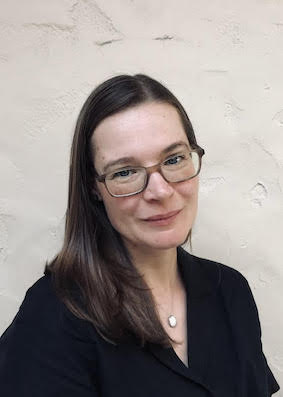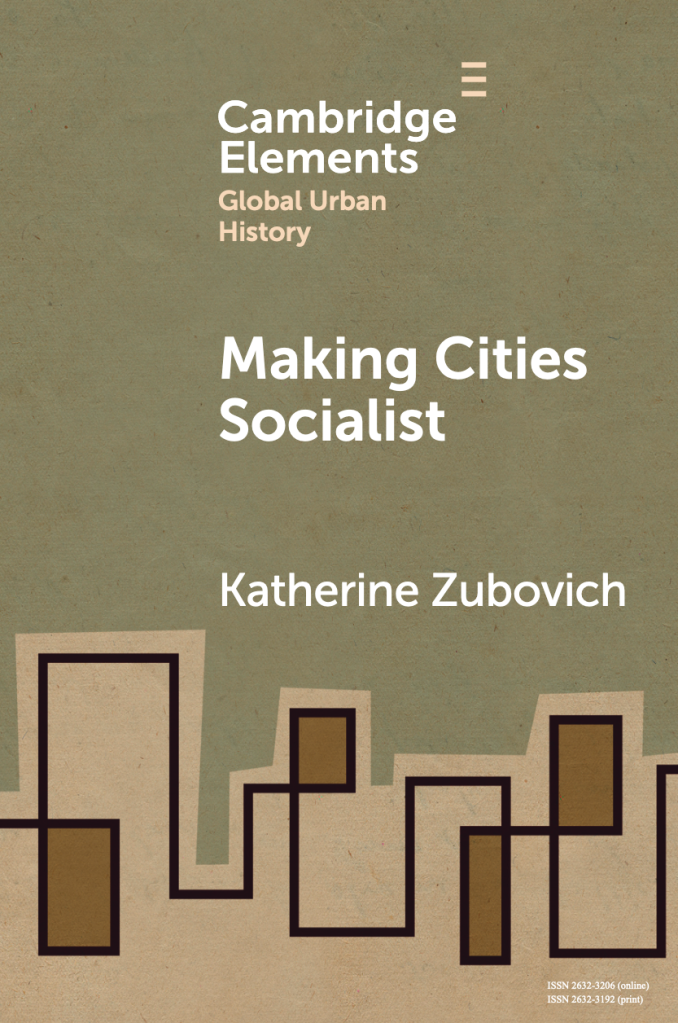To mark the publication of new contributions to our Cambridge Elements in Global Urban History series, we will feature interviews with authors and share short excerpts from their work. Here, GUHP Blog associate editor Maytal Mark interviews Katherine Zubovich, the author of Making Cities Socialist. Katherine Zubovich is Associate Professor of History at the University at Buffalo, SUNY. She is a historian of Russia and the former Soviet Union. Her book, Moscow Monumental: Soviet Skyscrapers and Urban Life in Stalin’s Capital, explores the history of skyscraper building in the Soviet capital during the Stalin era. An excerpt of Making Cities Socialist follows the interview.


Maytal Mark (MM): What does it mean to write about “socialist cities” — do you use the term as a typology, a framework, an analytical category, or in some other way?
Katherine Zubovich (KZ): Making Cities Socialist explores the history of urban planning, city building, and city life in the socialist world. The Element follows the global trajectories of architects, planners, and ideas about socialist urbanism that developed in the twentieth century, while also highlighting features of everyday life in socialist cities. I use the term “socialist city” to discuss cities that developed under state socialism, but I also acknowledge the many ways that places like Moscow, Havana, Warsaw, Dar es Salaam, Anshan, Nurek, and Beijing maintained connections to the non-socialist world. These connections were historical: while some socialist cities were built from scratch, most inherited the urban topographies and textures of previous regimes, whether capitalist or imperialist. These connections were also present in the socialist period, fueling the design and emergence of socialist spaces. Soviet cities built during the First Five-Year Plan era (1928-32), for example, relied on American, German, and other foreign architects and technologies for their construction. While I offer a broad definition of the “socialist city” early in the Element, one of the goals of the text is to show how much variation, as well as connection, there was across cities of the socialist world.
MM: What do you think global and urban historians can gain from studies of socialist cities?
KZ: For historians of global and urban history, socialist cities are interesting because of the global claims made by these spaces. One of the central arguments of the Element is that socialist cities were global by design; that is, socialist leaders and architects conceived of their cities as tools of world revolution. Socialist city plans were intended to travel and take root in a wide variety of geographies and cultural contexts. For those interested in alternative forms of globalization in the twentieth century (alternative to the more familiar cases of capitalist globalization), socialist cities are a good place to start. They allow us to think about how ideas, experts, and materials traveled throughout the socialist world, which encompassed one-third of the global population by 1980.
MM: In your Element you take a transnational and comparative approach — can you say a bit about what critical similarities and differences in socialist cities across the world drew your attention?
KZ: The Element opens with a section on the socialist city as it took shape first in the Soviet Union. Subsequent sections then take a comparative and transnational approach to the history of socialist urbanism, tracing socialist city development in the USSR, Eastern Europe, Asia, Africa, and Latin America. There are numerous similarities and differences we can trace across different cases. For example, in the USSR and Eastern Europe socialist leaders saw cities as key spaces of revolution. They located enormous power in cities and urban planning, seeing them as technologies that could fundamentally transform daily life, bringing it in line with communist ideology. This faith in the urban was not shared across the socialist world, however. In China, Cambodia, Tanzania, and Cuba, cities were less central to socialism—and how cities in these countries were planned, developed, and governed was different as a result.
MM: Elements are intended to be accessible to lay readers and their length makes them easy to assign in classes. How do you imagine your Element might fit into a university curriculum? Which classes might you assign it for? With what other readings would you pair it?
KZ: Making Cities Socialist can be assigned in specialized courses on socialist cities and in urban history survey courses. It was in teaching a course on “The City in History” that I first began to really think more globally about socialist urbanism myself. The Element or sections of it can also be assigned as part of urban modules within broader courses on Soviet, twentieth century East European, Asian, or African history. My hope is that readers will take the text as an opening or invitation for further study. The Element does not discuss all possible cases, of course, nor does it cite all possible literature. But it does open questions and starting points for undergraduate and graduate researchers engaged in the study of socialist urbanism.
In terms of pairings, the Element could help to frame in a more global way the articles and books cited in the bibliography. The Element can also be used to locate unexpected pairings across geographical fields of historical research. For example, Koji Hirata’s article on Anshan, “Mao’s Steeltown,” would pair very well with a chapter on Magnitogorsk from Christina Crawford’s book Spatial Revolution. I can imagine a very interesting course module on socialist steeltowns, framed by readings on these Chinese and Soviet cases.
MM: What made you interested in writing an Element, with its novel format?
KZ: I was excited at the prospect of approaching the topic of socialist cities from a global perspective and by the opportunity to expand my own reading and thinking by engaging with the growing body of scholarship on this topic. Taking a global historical approach to the study of socialist cities has allowed me to learn about new places and to see the Soviet cities I know through my own work in an entirely new way. It has also made me very aware and appreciative of how rich the scholarship is on socialist cities. I’m sure that other authors in the Elements in Global Urban History series will agree that writing an Element makes us very attentive to how reliant and indebted we are to the work of others. I think of Making Cities Socialist as a tribute to the wealth of scholarship on socialist cities that has been produced by an interdisciplinary group of scholars in the past decades.
MM: What are your current and future research projects? What can we expect from you next?
KZ: I have two projects currently on the go. First, I am working on a history of visual statistics and data visualization during the Stalin era. This topic moves me away somewhat from urban history, although, as I explore in this project, industrial facilities and cities were important spaces for the display of Soviet numerical graphics in the 1930s and 1940s. Second, I am beginning new research on the production and supply of construction materials for postwar urban reconstruction in the USSR after 1945. This project approaches cities in terms of the larger geographies and resources that produce them.
Making Cities Socialist is available in paperback and as an e-book; the e-book is free to download until March 25, 2024.
Excerpt from Making Cities Socialist
Broad paths cutting through the residential district made the new town of Cheremushki good for strolling, even on a cold winter day. The photograph in Figure 1 shows residents of this Soviet city out for a walk.
Figure 1: Residents of Cheremushki, located near the Sayano-Shushenskaya hydro power station, USSR, 1977.
Pushing their baby in a pram, with another child walking closely behind, the young family passes by birch trees, conifers, and a communal laundry line with sheets hung out to dry. A dozen or so prams belonging to other families living in the neighborhood are parked by each of the entrances to the apartment complex on the right. Benches near each entryway accommodate sitting outside when the weather warms. Another apartment building stands in the distance. This neighborhood, with its cluster of five-story buildings, was brand new, built for workers of the nearby Sayano-Shushenskaya dam located along the Yenisei River in southwestern Siberia. The first turbine of the dam, still one of the world’s largest hydroelectric power plants today, whirled into action in 1978, one year after this photograph was taken. The dam was designed by engineers in Leningrad, some 5,000 kilometers away. And like its designers, the dam’s workers also came from afar. It is likely that the residents pictured here were newcomers to this remote region, having joined thousands of other young workers like them in building and maintaining the dam and in populating this new Soviet town.
While residents of Cheremushki spent their days maintaining a unique piece of hydroelectric infrastructure, the urban settlement to which they returned each evening was not unique at all. Even the name of their new town signaled its ordinariness. Cheremushki (pronounced “cher-YO-moosh-ki,” from the word “cheremukha” or bird cherry tree) was a common name for new towns and suburban districts in the Soviet Union. (The name was so common that the Cheremushki pictured in this photograph is not the only Cheremushki along the Yenisei River. A second one is located 350 kilometers north.) Specialist readers will know that the most famous Cheremushki in the USSR was in the Soviet capital city of Moscow. In the late 1950s, Moscow’s Novye (New) Cheremushki district was the site of experiments in prefabricated mass housing construction. Ideas pioneered in Moscow in the 1950s can be seen in the Cheremushki along the Yenisei in the 1970s: the buildings in the photograph are similar to designs implemented in the southwest district of the capital two decades earlier.
There are distinctive features of the Cheremushki located along the Yenisei River, of course, like the dramatic peaks of the Sayan mountain range that frame the town before unfolding southward toward neighboring Mongolia. This corner of Siberia also has the distinction of being the site where a young revolutionary named Vladimir Ulyanov, who would soon adopt the pseudonym “Lenin,” served time in exile after Russian Tsarist officials found him guilty of sedition in 1897. But aside from these unique geographical and historical features, most elements of this Cheremushki along the Yenisei would have felt wholly familiar to the neighborhood’s inhabitants regardless of where in the Soviet Union they were from. Right down to the design of the benches by the entryways, the five-story prefabricated apartment blocks pictured here were ubiquitous in cities across the USSR and beyond by the 1970s. Isolated though they were in their remote new town, the family in this photograph lived in a socialist city that formed part of a global network of urban spaces, connected by a shared set of spatial and ideological practices.

